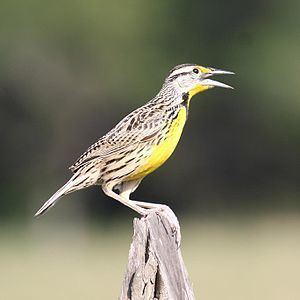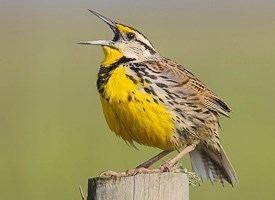Order Passeriformes Genus Sturnella Higher classification Meadowlark | Phylum Chordata Scientific name Sturnella magna Rank Species | |
 | ||
Similar Meadowlark, Bird, Western meadowlark, Bobolink, Grasshopper sparrow | ||
Eastern meadowlark
The eastern meadowlark (Sturnella magna) is a medium-sized icterid bird, very similar in appearance to the western meadowlark. It occurs from eastern North America to South America, where it is also most widespread in the east.
Contents

Eastern meadowlark song
Description

The adult eastern meadowlark measures from 19 to 28 cm (7.5 to 11.0 in) in length and spans 35–40 cm (14–16 in) across the wings. Body mass ranges from 76 to 150 g (2.7 to 5.3 oz). The extended wing bone measures 8.9–12.9 cm (3.5–5.1 in), the tail measures 5.3–8.6 cm (2.1–3.4 in), the culmen measures 2.8–3.7 cm (1.1–1.5 in) and the tarsus measures 3.6–4.7 cm (1.4–1.9 in). Females are smaller in all physical dimensions. Adults have yellow underparts with a black "V" on the breast and white flanks with black streaks. The upperparts are mainly brown with black streaks. They have a long pointed bill; the head is striped with light brown and black.
The song of this bird is of pure, melancholy whistles, and thus simpler than the jumbled and flutey song of the western meadowlark; their ranges overlap across central North America. In the field, the song is often the easiest way to tell the two species apart, though plumage differences do exist, like tail pattern and malar coloration.
The pale Lilian's meadowlark of northern Mexico and the southwestern US is sometimes split off as a separate species.
Taxonomy
This species was first described by Linnaeus in his 1758 Systema naturae as Alauda magna. The type locality is mistakenly given as "America, Africa".
Linnaeus' error is explained by two facts: first, he did not distinguish between the eastern and western meadowlarks. The peculiar belief that this bird also occurred in Africa is due to confusion of the yellow-breasted meadowlarks with certain longclaws (Macronyx), quite unrelated African songbirds. Specifically the Cape longclaw (M. capensis) and the yellow-throated longclaw (M. croceus) share similar habitat and habits, explaining the long hind toe; their plumage pattern however is all but identical, a striking example of convergent evolution. As this exact pattern provides no obvious adaptive benefit compared to that of other meadowlarks and longclaws, it seems to have arisen twice by sheer chance.
Linnaeus recognized his error less than a decade later, separating the longclaws from their meadowlark look-alikes.
The scientific name Sturnella magna is Latin for, rather confusingly, "large little starling", the generic name having been given due to the meadowlarks' behavior being similar to starlings.
Ecology
Their breeding habitat is grasslands and prairie, also pastures and hay fields. This species is a permanent resident throughout much of its range, though most northern birds migrate southwards in winter. In 1993 this species was first recorded in El Salvador, and the discovery of a breeding pair in 2004 confirmed that the species is a resident there.
These birds forage on the ground or in low vegetation, sometimes probing with the bill. They mainly eat arthropods, but also seeds and berries. In winter, they often feed in flocks.
Nesting occurs throughout the summer months. The nest is also on the ground, covered with a roof woven from grasses. There may be more than one nesting female in a male's territory.
The numbers of this species increased as forests were cleared in eastern North America. This species is ideally suited to farmland areas, especially where tall grasses are allowed to grow. Their numbers are now shrinking with a decline in suitable habitat. On the other hand, its range is expanding in parts of Central America toward the Pacific (western) side of the continent, in agricultural-type areas.
Conservation efforts
Eastern meadowlarks are species at risk in Nova Scotia and the subject of agricultural conservation program seeking to reduce mortality through modified practices. Allowing marginal areas of fields on farms to seed with grass can provide nesting habitat for meadowlarks and all grassland birds. Delaying hay harvest can also improve survival, giving young meadowlarks a chance of fledging
